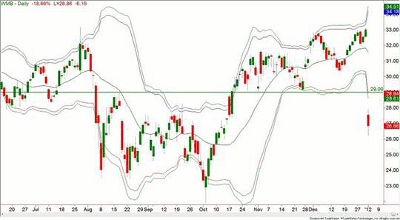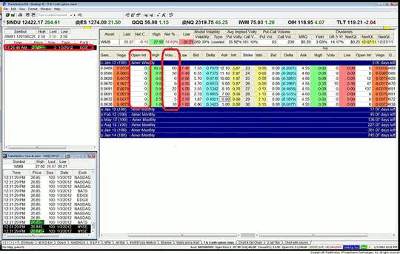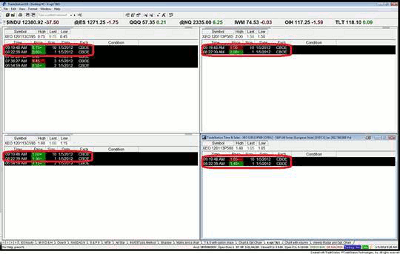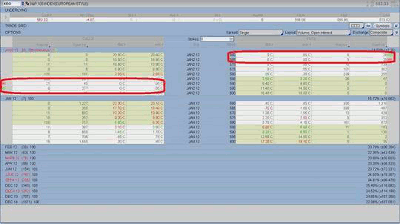These trades were inspired by high-quality technical set-ups, and despite very low open interest—a common red flag for traders—both were profitable, proving there are exceptions to the “rules” on open interest.
In this article, I will compare two trades: one of mine and one from a trader who shared his trade with me, asking for my take on it. The trades were very similar in a sense that the underlying products were optionable and they both had weekly options listed. They also both had individual strike prices with very little or no open interest and volume. Should we even be considering trades on options like these that have such low liquidity?
Trade #1: Weekly Option Trade on Williams Cos, Inc. (WMB)
The first trade was on WMB, which had a great technical set-up on the chart.
The stock gapped four standard deviations down, and the trader executed a buy-write covered call strategy. He simultaneously purchased 500 shares of the WMB stock for $27 and sold five weekly 29 calls on it for $2.50 per contract. His BEP (breakeven point) was $24.50 ($27-$2.50).
When he contacted me, he was quite surprised that his weekly options that had only four more days of life span left had such rich premium. The Jan week A options were expiring on Friday, January 6, and for him, all that needed to happen to keep $2.50 in credit was for WMB to stay below $29.
I was able to see his footprint on time and sales because that particular weekly 29 call did not trade many contracts that Tuesday morning, January 3, 2012.
Because of the lack of open interest and volume on the individual strike prices, this trade does not fit many traders’ requirements for an option trade. However, the bottom line is that the trade worked out perfectly. On January 6, the stock closed at $27.39 and the trader made a profit of $0.39 per share, plus he kept all the credit he received from selling the 29 calls.
NEXT: Trade # 2: Weekly Option Trade on European S&P 100 Index
|pagebreak|Trade #2: Weekly Option Trade on European S&P 100 Index ($XEO)
Similarly, in my trade on the European S&P 100 Index ($XEO), the set-up looked great technically. The index was trading below the 590 level and strongly above the 565 level. However, the open interest and volume on the individual strike prices of these weekly options were quite low.
The question that I had in mind on that Thursday morning (January 5, 2012) when Jan week B options were listed was, "Do I talk myself out of a perfectly reasonable trade, technically, because of the lack of option liquidity?"
Ultimately, the decision had to be made based on the question of whether the trade was worth the risk taken. (Or, as some traders say: Is the payoff worth the aggravation?)
In my opinion, the answer was yes; however, I did first send in a foot soldier (a single contract) to discover what the best possible price was that I could get for my 595/590/565/560 iron condor.
Initially, I asked for a credit of $1.45, then $1.40, then $1.35, but it was only at $1.30 that I was finally filled. Next, I sent in the order with my troops (ten contracts) to be filled at the same price, which they eventually were.
Those familiar with the iron condor strategy know that I risked only $3.70 ($5.00 spread minus the credit) to make $1.30. For a directional trade, this would not make any sense because more is being risked than what the potential reward is. However, this iron condor was a non-directional trade so the bottom line of what is at risk needs to be taken into account.
Between Thursday morning (January 5, 2012) and the close on Friday (January 13, 2012), XEO could trade anywhere as long as it did not close above $590 or below $565. At the entry, XEO was at $580, and on the last day, it closed barely above $580.
The risk/reward on this trade can be calculated ($1.30/$3.70) to get the rate of return on this investment. In this particular case, it is 35% within a week.
This last figure shows the outcome for the XEO trade. However, let us go back to the original question: Could I have talked myself out of a perfect technical set-up because of the lack of option liquidity on XEO? Could anyone?
In conclusion, a lack of open interest and volume on individual strike prices is often associated with a lack of liquidity. However, if we are sellers of options and "the price is right" (just like the TV show), then occasionally, it is acceptable to (option) trade in such an environment.
As long as we are aware that if we are wrong and need to buy back our obligation, we will have to take full responsibility for our actions. In other words, pay a higher premium price because of the slippage.
Ultimately, everything comes down to whether we are trading on a good technical set-up or not. Sometimes you do not have to talk yourself out of a good trade because of some small imperfections.
By Josip Causic, instructor, Online Trading Academy














